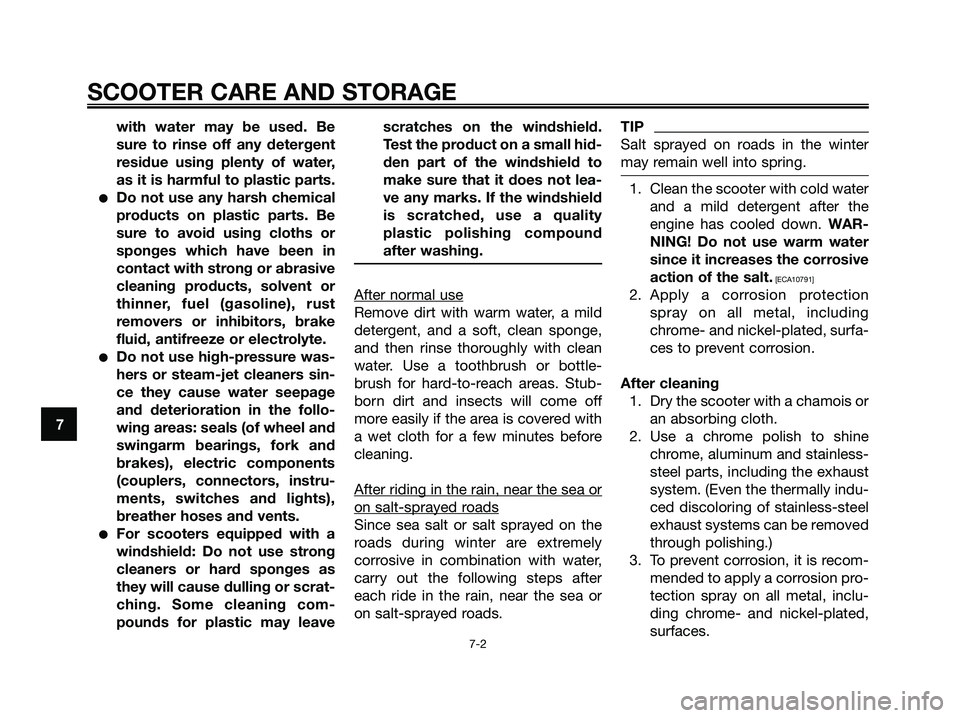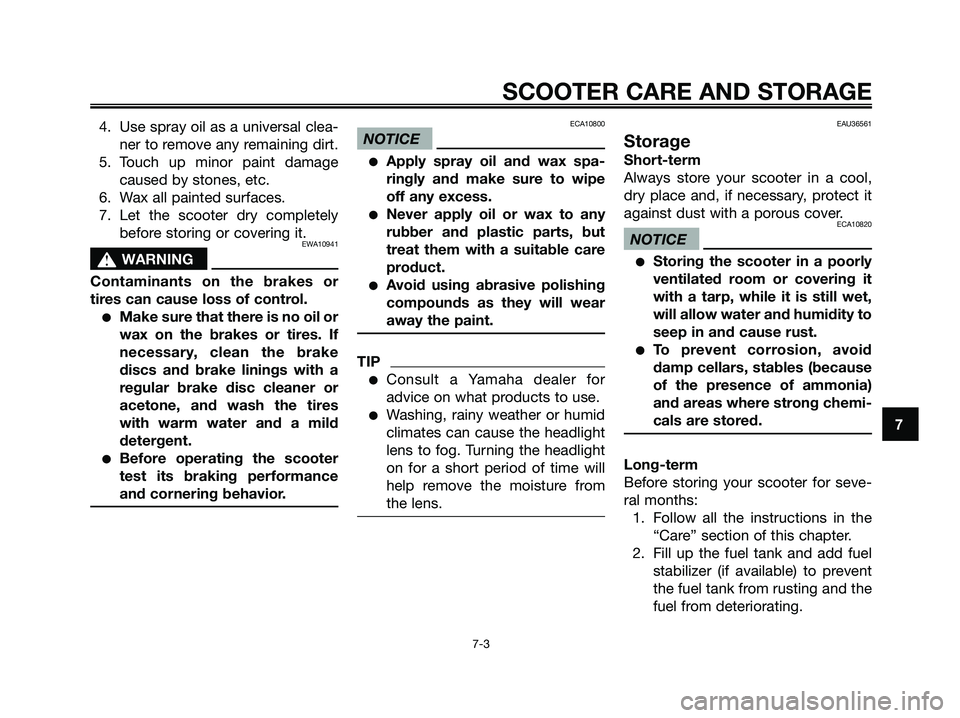2009 YAMAHA XMAX 125 fuel
[x] Cancel search: fuelPage 74 of 92

1. Auxiliary light bulb
4. Insert a new bulb into the socket.
5. Install the socket (together with
the bulb) by pushing it in.
6. Install the cowling.
EAU25881
Troubleshooting
Although Yamaha scooters receive a
thorough inspection before shipment
from the factory, trouble may occur
during operation. Any problem in the
fuel, compression, or ignition sys-
tems, for example, can cause poor
starting and loss of power.
The following troubleshooting charts
represent quick and easy procedures
for checking these vital systems your-
self. However, should your scooter
require any repair, take it to a Yamaha
dealer, whose skilled technicians
have the necessary tools, experience,
and know-how to service the scooter
properly.
Use only genuine Yamaha replace-
ment parts. Imitation parts may look
like Yamaha parts, but they are often
inferior, have a shorter service life and
can lead to expensive repair bills.
EWA15141
s s
WARNING
When checking the fuel system, do
not smoke, and make sure there
are no open flames or sparks in the
area, including pilot lights from
water heaters or furnaces. Gasoli-
ne or gasoline vapors can ignite or
explode, causing severe injury or
property damage.
PERIODIC MAINTENANCE AND ADJUSTMENT
6-32
6
1B9-F8199-E3.QXD 21/10/08 13:43 Página 74
Page 75 of 92

EAU42131
Troubleshooting charts
Starting problems or poor engine performance
Check the fuel level in
the fuel tank.
1. FuelThere is enough fuel.
There is no fuel.Check the compression.
Supply fuel.
The engine does not start.
Check the compression.
Operate the electric starter.
2. CompressionThere is compression.
There is no compression.Check the ignition.
Have a Yamaha dealer
check the vehicle.
Remove the spark plug
and check the electrodes.
3. IgnitionWipe off with a dry cloth and correct the
spark plug gap, or replace the spark plug.
Have a Yamaha dealer check the vehicle.
The engine does not start.
Have a Yamaha dealer
check the vehicle.
The engine does not start.
Check the battery.
Operate the electric starter.
4. BatteryThe engine turns over
quickly.
The engine turns over
slowly.The battery is good.
Check the battery lead connections,
and charge the battery if necessary.
Dry
We tOperate the electric starter.
PERIODIC MAINTENANCE AND ADJUSTMENT
6-33
6
1B9-F8199-E3.QXD 21/10/08 13:43 Página 75
Page 78 of 92

SCOOTER CARE AND STORAGE
7-2
7with water may be used. Be
sure to rinse off any detergent
residue using plenty of water,
as it is harmful to plastic parts.
●Do not use any harsh chemical
products on plastic parts. Be
sure to avoid using cloths or
sponges which have been in
contact with strong or abrasive
cleaning products, solvent or
thinner, fuel (gasoline), rust
removers or inhibitors, brake
fluid, antifreeze or electrolyte.
●Do not use high-pressure was-
hers or steam-jet cleaners sin-
ce they cause water seepage
and deterioration in the follo-
wing areas: seals (of wheel and
swingarm bearings, fork and
brakes), electric components
(couplers, connectors, instru-
ments, switches and lights),
breather hoses and vents.
●For scooters equipped with a
windshield: Do not use strong
cleaners or hard sponges as
they will cause dulling or scrat-
ching. Some cleaning com-
pounds for plastic may leavescratches on the windshield.
Test the product on a small hid-
den part of the windshield to
make sure that it does not lea-
ve any marks. If the windshield
is scratched, use a quality
plastic polishing compound
after washing.
After normal use
Remove dirt with warm water, a mild
detergent, and a soft, clean sponge,
and then rinse thoroughly with clean
water. Use a toothbrush or bottle-
brush for hard-to-reach areas. Stub-
born dirt and insects will come off
more easily if the area is covered with
a wet cloth for a few minutes before
cleaning.
After riding in the rain, near the sea or
on salt-sprayed roads
Since sea salt or salt sprayed on the
roads during winter are extremely
corrosive in combination with water,
carry out the following steps after
each ride in the rain, near the sea or
on salt-sprayed roads.
TIP
Salt sprayed on roads in the winter
may remain well into spring.
1. Clean the scooter with cold water
and a mild detergent after the
engine has cooled down. WAR-
NING! Do not use warm water
since it increases the corrosive
action of the salt.
[ECA10791]
2. Apply a corrosion protection
spray on all metal, including
chrome- and nickel-plated, surfa-
ces to prevent corrosion.
After cleaning
1. Dry the scooter with a chamois or
an absorbing cloth.
2. Use a chrome polish to shine
chrome, aluminum and stainless-
steel parts, including the exhaust
system. (Even the thermally indu-
ced discoloring of stainless-steel
exhaust systems can be removed
through polishing.)
3. To prevent corrosion, it is recom-
mended to apply a corrosion pro-
tection spray on all metal, inclu-
ding chrome- and nickel-plated,
surfaces.
1B9-F8199-E3.QXD 21/10/08 13:43 Página 78
Page 79 of 92

4. Use spray oil as a universal clea-
ner to remove any remaining dirt.
5. Touch up minor paint damage
caused by stones, etc.
6. Wax all painted surfaces.
7. Let the scooter dry completely
before storing or covering it.
EWA10941
s s
WARNING
Contaminants on the brakes or
tires can cause loss of control.
●Make sure that there is no oil or
wax on the brakes or tires. If
necessary, clean the brake
discs and brake linings with a
regular brake disc cleaner or
acetone, and wash the tires
with warm water and a mild
detergent.
●Before operating the scooter
test its braking performance
and cornering behavior.
ECA10800
NOTICE
●Apply spray oil and wax spa-
ringly and make sure to wipe
off any excess.
●Never apply oil or wax to any
rubber and plastic parts, but
treat them with a suitable care
product.
●Avoid using abrasive polishing
compounds as they will wear
away the paint.
TIP
●Consult a Yamaha dealer for
advice on what products to use.
●Washing, rainy weather or humid
climates can cause the headlight
lens to fog. Turning the headlight
on for a short period of time will
help remove the moisture from
the lens.
EAU36561
Storage
Short-term
Always store your scooter in a cool,
dry place and, if necessary, protect it
against dust with a porous cover.
ECA10820
NOTICE
●Storing the scooter in a poorly
ventilated room or covering it
with a tarp, while it is still wet,
will allow water and humidity to
seep in and cause rust.
●To prevent corrosion, avoid
damp cellars, stables (because
of the presence of ammonia)
and areas where strong chemi-
cals are stored.
Long-term
Before storing your scooter for seve-
ral months:
1. Follow all the instructions in the
“Care” section of this chapter.
2. Fill up the fuel tank and add fuel
stabilizer (if available) to prevent
the fuel tank from rusting and the
fuel from deteriorating.
SCOOTER CARE AND STORAGE
7-3
7
1B9-F8199-E3.QXD 21/10/08 13:43 Página 79
Page 81 of 92

Dimensions:Overall length:
2210 mm (87.0 in)
Overall width:
790 mm (31.1 in)
Overall height:
1380 mm (54.3 in)
Seat height:
785 mm (30.9 in)
Wheelbase:
1545 mm (60.8 in)
Ground clearance:
112 mm (4.44 in)
Minimum turning radius:
3650 mm (143.7 in)
Weight:With oil and fuel:
166 kg (366 lb)
Engine:Engine type:
Liquid cooled 4-stroke, SOHC
Cylinder arrangement:
Forward-inclined single cylinder
Displacement:
124.6 cm
3
Bore x stroke:
52.0 x 58.6 mm (2.05 x 2.31 in)
Compression ratio:
11.20 :1
Starting system:
Electric starter
Lubrication system:
Wet sump
Engine oil:Type:
SAE 10W-30, SAE 10W-40, SAE 15W-40,
SAE 20W-40 or SAE 20W-50
Recommended engine oil grade:
API service SG type or higher, JASO
standard MA
Engine oil quantity:
Without oil filter cartridge replacement:
1.40 L (1.48 US qt) (1.23 Imp.qt)
With oil filter element replacement:
1.50 L (1.59 US qt) (1.32 Imp.qt)
Final transmission oil:Type:
SAE 10W-30 type SE motor oil
Quantity:
0.21 L (0.22 US qt) (0.18 Imp.qt)
Cooling system:Coolant reservoir capacity (up to the
maximum level mark):
0.26 L (0.27 US qt) (0.23 Imp.qt)
Radiator capacity (including all routes):
1.40 L (1.48 US qt) (1.23 Imp.qt)
Air filter:Air filter element:
Oil-coated paper element
Fuel:Recommended fuel:
Regular unleaded gasoline only
Fuel tank capacity:
12.5 L (3.30 US gal) (2.75 Imp.gal)
Fuel reserve amount:
2 L (0.53 US gal) (0.44 Imp.gal)
Throttle body:Type/quantity:
EFI (1B9) / 1
Manufacturer:
AISAN
Spark plug (s):Manufacturer/model:
NGK/ CPR 9EA-9
Spark plug gap:
0.8-0.9 mm (0.031-0.035 in)
Clutch:Clutch type:
Dry, centrifugal automatic
Transmission:Primary reduction system:
Helical gear
Primary reduction ratio:
41/14 (2.929)
Secondary reduction system:
Helical gear
Secondary reduction ratio:
44/13 (3.384)
Transmission type:
V-belt automatic
SPECIFICATIONS
8-1
8
1B9-F8199-E3.QXD 21/10/08 13:43 Página 81
Page 86 of 92

AAcceleration and deceleration ...................5-3
Air filter and V-belt case air filter
elements ................................................6-14
Anti-theft alarm (optional) ..........................3-9
Auxiliary light bulb, replacing ...................6-31
BBattery......................................................6-24
Brake fluid level, checking .......................6-20
Brake fluid, changing ...............................6-21
Brake lever, front ......................................3-10
Brake lever, rear .......................................3-10
Brake levers, lubricating ..........................6-22
Braking .......................................................5-3
CCables, checking and lubricating ............6-21
Care............................................................7-1
Catalytic converters .................................3-13
Centerstand and sidestand, checking
and lubricating .......................................6-22
Coolant.....................................................6-13
Coolant temperature gauge .......................3-5
Cowlings and panel, removing and
installing ...................................................6-6
DDimmer switch ...........................................3-9
Display, multi-function ...............................3-6
EEngine break-in ..........................................5-4
Engine oil ...................................................6-9
Engine trouble warning light ......................3-4
FFinal transmission oil ...............................6-12
Front and rear brake lever free play.........6-19Front and rear brake pads, checking ......6-19
Front fork, checking .................................6-23
Front storage compartment .....................3-16
Fuel ..........................................................3-12
Fuel consumption, tips for reducing ..........5-4
Fuel gauge .................................................3-5
Fuel level warning light ..............................3-4
Fuel tank cap ...........................................3-11
Fuses, replacing .......................................6-26
HHandlebar switches ...................................3-9
Hazard switch ..........................................3-10
Headlight bulb, replacing .........................6-28
High beam indicator light...........................3-3
Horn switch ................................................3-9
IIdentification numbers ...............................9-1
Ignition circuit cut-off system ..................3-19
Immobilizer system ....................................3-1
Immobilizer system indicator light .............3-4
Indicator and warning lights ......................3-3
KKey identification number ..........................9-1
LLicense plate light bulb, replacing ...........6-31
MMain switch/steering lock ..........................3-2
Maintenance and lubrication, periodic ......6-3
Maintenance, emission control system .....6-2
Matte color, caution ...................................7-1
Model label ................................................9-2
PParking .......................................................5-5
Part locations .............................................2-1Periodic maintenance and lubrication
chart .........................................................6-2
RRear storage compartment ......................3-17
SSafe-riding points.......................................1-5
Safety information ......................................1-1
Seat ..........................................................3-14
Securing bracket ......................................3-14
Shock absorber assemblies, adjusting....3-18
Sidestand .................................................3-18
Spark plug, checking .................................6-8
Specifications.............................................8-1
Speedometer .............................................3-5
Start switch ................................................3-9
Starting off .................................................5-2
Starting the engine.....................................5-1
Steering, checking ...................................6-24
Storage.......................................................7-3
Storage compartments ............................3-15
TTail/brake light bulb or rear turn signal
light bulb, replacing ...............................6-29
Throttle cable free play, adjusting ............6-15
Throttle grip and cable, checking and
lubricating ..............................................6-22
Tires .........................................................6-16
Tool kit ........................................................6-1
Troubleshooting .......................................6-32
Troubleshooting charts ............................6-33
Turn signal indicator lights .........................3-3
Turn signal light bulb (front), replacing ....6-29
Turn signal switch ......................................3-9
INDEX
1B9-F8199-E3.QXD 21/10/08 13:43 Página 86